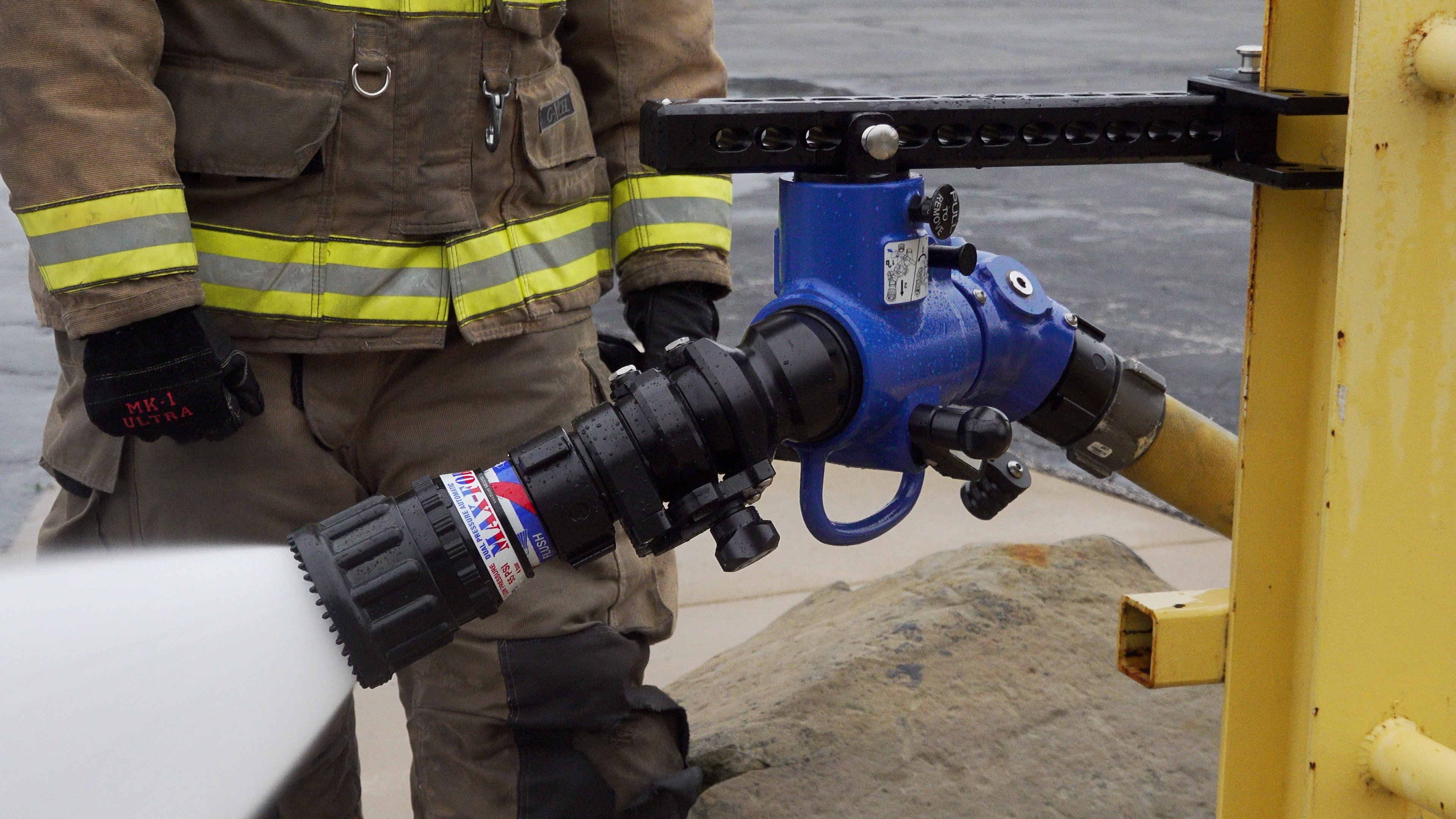Summary: When you’re fighting fire in confined, elevated or odd ball spots, standard “ground” monitors often won’t cut it. You might need to hook water to a tank lip, scaffold, stair rail or hitch receiver to get the job done. The Hemisphere monitor from Task Force Tips solves that by offering up to 500 GPM (2 000 L/min) flow, full 360° rotation and 80° pivoting water stream sweep, and a suite of mounting clamps (I‑beam, tank lip, hitch, pipe/rail) so you can clamp “big water” into unusual places fast.
Clamp Big Water Anywhere With the Hemisphere Monitor
If your department is seeing more industrial fires, awkward structure layouts or elevated exposures like mezzanines, rails, rooftops or tank farms, you’re dealing with three main headaches: difficult access, limited stream direction and slow setup. Here’s how this monitor addresses each.
Tackling Hard-to-Reach Areas
Ground-mounted monitors assume a stable, flat mounting surface and mostly horizontal sweep. The Hemisphere, by contrast, is designed to attach to irregular or elevated surfaces like I-beams, round pipes, tank lips, hand rails, or even a hitch receiver on a rig. Because the mount is quick-attach and portable, you can deploy big water where you otherwise could only hope to get a high-pressure handline.
Precision Stream Control: Aim Almost Anywhere
The device gives you a full 360-degree rotation of the main waterway and an additional 80-degree pivot via a double-ball swivel, allowing the outlet to sweep across nearly an entire hemisphere of space. This means you can clamp it to a mezzanine railing and aim downward into a pit, or mount on a tank lip and angle it inward without repositioning the whole monitor. That flexibility matters in tight spaces.
Faster Setup and Redeployment
With its lightweight aluminum body, built-in carrying handle and tool-free quick-attach mounting system, the Hemisphere is built to get water flowing fast. And the system is modular: one monitor body, multiple mounts. So you might carry a backbone clamp system on your rig and choose the proper clamp onsite rather than a dedicated fixed monitor per location.
How to Use It in the Field
Here’s a quick playbook for deploying the Hemisphere effectively.
Step A: Pre-Plan Mounting Locations
-
Walk your facility or pre-incident map to identify I-beams, accessible rails, tank lips or hitch points
-
Confirm the structure can safely handle nozzle reaction, hose weight and water load
-
If possible, pre-position the clamp or backbone on the rig or in the building
Step B: Deploy the Monitor On-Scene
-
Select the proper mounting clamp such as I-beam, hitch mount, tank lip clamp or flex clamp for round pipe
-
Secure it firmly, making sure the clamp is on a structurally sound surface
-
Slide the monitor body onto the base mount and verify the release pin is seated
-
Connect the hose, roughly aim the monitor and use the crank handles and pivot for fine-tuning
-
Lock both the rotation and pivot so the monitor doesn’t drift once flowing
-
Open the quarter-turn valve with the locking bail-type handle to begin flow gradually
Step C: Targeting and Stream Adjustment
-
The integrated stream straightener helps deliver efficient reach with minimal turbulence
-
Fine-tune the aim while flowing if needed, using the crank rotation and pivot
-
Keep an eye on the clamp, hose and mounting surface during operation
Step D: Shut-Down and Reset
-
Close the valve completely before removing the monitor
-
Wait until pressure drops and hose is drained before unlocking the mounting pin
-
Clean and stow the monitor, especially if used in salt or corrosive environments
Common Mistakes and How to Avoid Them
Clamping to a weak surface
Avoid mounting to materials like thin metal, fireproofing, or anything compromised. The surface must support the combined force of water flow and hose drag.
Trying to reposition while flowing
Always lock the monitor in place before charging the line. Adjusting under flow risks losing control of the stream.
Ignoring hose torque effects
Keep hose lines supported and minimize pull on the clamp. Route the hose as directly and close to the mount as possible.
Not using the modular clamp system
Carrying just one monitor with interchangeable mounts gives you tactical flexibility without needing multiple setups.
When Does the Hemisphere Make Sense?
Ideal for:
-
Elevated or vertical exposures like mezzanines, rooftops or tank tops
-
Industrial or petro-chemical sites where fire risk exists in unconventional locations
-
Departments needing flexible deployment across multiple sites
Less ideal if:
-
Most fires are accessible from ground-level with traditional monitors
-
Structural supports or water supply can’t handle 500 GPM setup
-
You need ultra-lightweight gear and have no room for clamps or mounts
Final Thoughts: Big Water in Unusual Places
This isn’t just another monitor. It’s a tactical tool for putting high-volume water exactly where you want it, even if that’s on a tank lip, scaffold, stair rail or hitch receiver. If your fireground demands flexibility and precision in unconventional spots, the Hemisphere is built to clamp in and deliver.



Comments